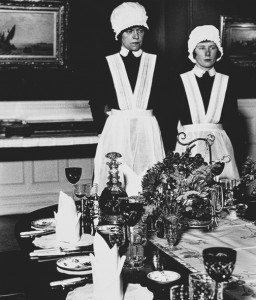The twentieth-century photographer Bill Brandt (1904-1983) took photographs of the servants working in wealthy households and coal miners in modest dwellings. His photographs often juxtaposed the working class and those with privilege. The images show the abundance of the upper classes, including the banker whose servants are pictured here about to serve dinner at a country home. Historically, the number of servants has long been equated to the status of the household, more help reflects greater importance. One of the most extravagant displays of status through food was the royal court of the French King Louis XIV at Versailles outside Paris. Watch an excerpt from a film by Roberto Rossellini, La Prise du Pouvoir par Louis XIV aka The Rise of Louis XIV (1966) that recreates the dinner service of Louis XIV. The excerpt is in French with English subtitles. Note how many cooks and servants are required to serve one man. In our own times, have you noticed how food can communicate status? at parties? weddings? or even picnics? Post an example of how food can be make a social statement.
Watch the excerpt from Rossellini’s film here.
PLEASE SUBMIT YOUR POSTS BY MONDAY OCTOBER 26, 2015.




